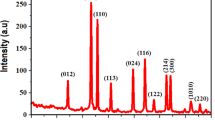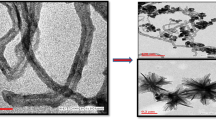Abstract
Global development of nanostructured bioceramics with enhanced functionalities has provided an insight into orthopedic, dental, and other biomedical applications. The present work reports a cost-effective and eco-friendly method for the green synthesis of magnesium oxide (MgO) nanoflakes (NFs) using Ficus Racemosa leaf extract. The NFs were subjected to different characterization techniques like X-ray diffraction, field emission scanning electron microscopy, energy-dispersive spectroscopy, Fourier-transform infrared spectroscopy, ultraviolet–visible, and photoluminescence spectroscopy to detect their structural, physical, chemical, and elemental characteristics. The powder X-ray diffraction of MgO NFs revealed the single phase with an average crystallite size of 24 nm. The Williamson–Hall plot also confirmed the crystallite size as 28 nm, nearly the same as obtained through Debye–Scherrer (24 nm) formula. Field emission scanning electron microscopy revealed the flake-like structure with an average thickness of 3 nm, and the average length was depicted as 280 nm. The ultraviolet–visible absorption spectra of MgO NFs showed a maximum wavelength of around 275 nm, and photoluminescence spectroscopy was used to observe the fluorescent properties. The antibacterial activity of MgO NFs against both S. aureus and E. coli bacteria demonstrated a significant reaction, making it a promising agent for several biomedical applications.
Graphical abstract














Similar content being viewed by others
References
A. Matlack, Introduction to green chemistry (CRC Press, 2010)
E. Mastronardi et al., Strategic role of nanotechnology in fertilizers: potential and limitations, in Nanotechnologies in food and agriculture. (Springer, 2015), pp. 25–67
P.K. Dikshit et al., Green synthesis of metallic nanoparticles: applications and limitations. Catalysts 11(8), 902 (2021)
Varshney, S., et al., An overview on biomedical applications of versatile silica nanoparticles, synthesized via several chemical and biological routes: A review. Phosphorus, Sulfur, and Silicon and the Related Elements, 2021: p. 1–17.
R.S. Varma, Greener and sustainable trends in synthesis of organics and nanomaterials (ACS Publications, 2016)
J. Singh et al., ‘Green’synthesis of metals and their oxide nanoparticles: applications for environmental remediation. J. Nanobiotechnol. 16(1), 1–24 (2018)
S. Iravani et al., Synthesis of silver nanoparticles: chemical, physical and biological methods. Res. Pharm. Sci. 9(6), 385 (2014)
X. Li et al., Biosynthesis of nanoparticles by microorganisms and their applications. J. Nanomater. 2011, 1–16 (2011)
M.L. Guimarães et al., Green synthesis of silver nanoparticles using Ziziphus joazeiro leaf extract for production of antibacterial agents. Appl. Nanosci. 10(4), 1073–1081 (2020)
I. Lashin et al., Antimicrobial and in vitro cytotoxic efficacy of biogenic silver nanoparticles (Ag-NPs) fabricated by callus extract of Solanum incanum L. Biomolecules 11(3), 341 (2021)
S.H. El-Moslamy, Bioprocessing strategies for cost-effective large-scale biogenic synthesis of nano-MgO from endophytic Streptomyces coelicolor strain E72 as an anti-multidrug-resistant pathogens agent. Sci. Rep. 8(1), 1–22 (2018)
T.H.Y. Duong et al., Synthesis of magnesium oxide nanoplates and their application in nitrogen dioxide and sulfur dioxide adsorption. J. Chem. 2019, 1–9 (2019)
F. Stippich et al., Enhanced corrosion protection of magnesium oxide coatings on magnesium deposited by ion beam-assisted evaporation. Surf. Coat. Technol. 103, 29–35 (1998)
L.C. Zhao et al., Influence of in situ MgO coating on corrosion resistance of pure Magnesium in normal saline, in Advanced materials research. (Trans Tech Publ, 2009)
A.A. Pilarska, Ł Klapiszewski, T. Jesionowski, Recent development in the synthesis, modification and application of Mg (OH) 2 and MgO: a review. Powder Technol. 319, 373–407 (2017)
T. Lewis, A. Wright, The electrical conductivity of magnesium oxide at low temperatures. J. Phys. D Appl. Phys. 1(4), 441 (1968)
M. Sain et al., Flame retardant and mechanical properties of natural fiber–PP composites containing magnesium hydroxide. Polym. Degrad. Stab. 83(2), 363–367 (2004)
Y. Ding et al., Nanoscale magnesium hydroxide and magnesium oxide powders: control over size, shape, and structure via hydrothermal synthesis. Chem. Mater. 13(2), 435–440 (2001)
T.A. Ranathunge et al., Doxorubicin loaded magnesium oxide nanoflakes as pH dependent carriers for simultaneous treatment of cancer and hypomagnesemia. Nanomaterials 9(2), 208 (2019)
N.J. Sushma et al., Facile approach to synthesize magnesium oxide nanoparticles by using Clitoria ternatea—characterization and in vitro antioxidant studies. Appl. Nanosci. 6(3), 437–444 (2016)
J.C. Yu et al., Synthesis and characterization of porous magnesium hydroxide and oxide nanoplates. J. Phys. Chem. B 108(1), 64–70 (2004)
X. Cao et al., Preparation of petal-like magnesium hydroxide particles by adding sulfate ions. J. Cryst. Growth 550, 125841 (2020)
S. Stankic et al., Size-dependent optical properties of MgO nanocubes. Angew. Chem. Int. Ed. 44(31), 4917–4920 (2005)
H. Duan, D. Wang, Y. Li, Green chemistry for nanoparticle synthesis. Chem. Soc. Rev. 44(16), 5778–5792 (2015)
K.V. Rao, C. Sunandana, Structure and microstructure of combustion synthesized MgO nanoparticles and nanocrystalline MgO thin films synthesized by solution growth route. J. Mater. Sci. 43(1), 146–154 (2008)
K. Tharani et al., Fabrication of Magnesium oxide nanoparticles using combustion method for a biological and environmental cause. Chem. Phys. Lett. 763, 138216 (2021)
J.-Y. Park et al., Chemical synthesis and characterization of highly oil dispersed MgO nanoparticles. J. Ind. Eng. Chem. 12(6), 882–887 (2006)
K.G. Rao et al., Structural properties of MgO nanoparticles: synthesized by co-precipitation technique. Int. J. Sci. Res. 3(12), 43–46 (2014)
L.S. Rao et al., Structural and optical properties of zinc magnesium oxide nanoparticles synthesized by chemical co-precipitation. Mater. Chem. Phys. 203, 133–140 (2018)
R. Agrawal et al., Synthesis and characterization of magnesium oxide nanoparticles with 1: 1 molar ratio via liquid-phase method. Int. J. Appl. Innov. Eng. Manag. 4(2), 141–145 (2015)
M.Y. Nassar et al., MgO nanostructure via a sol-gel combustion synthesis method using different fuels: an efficient nano-adsorbent for the removal of some anionic textile dyes. J. Mol. Liq. 225, 730–740 (2017)
A. Nigam, S. Pawar, Structural, magnetic, and antimicrobial properties of zinc doped magnesium ferrite for drug delivery applications. Ceram. Int. 46(4), 4058–4064 (2020)
A. Nigam, K. Kalauni, S. Pawar, 2022 Physio-chemical characterizations and antimicrobial properties of nano-sized Mg-Zn ferrite particles for biomedical applications. Mater. Technol. (2022). https://doi.org/10.1080/10667857.2022.2043649
M. Kandiban, P. Vigneshwaran, I.V. Potheher. Synthesis and characterization of MgO nanoparticles for photocatalytic applications. in Department of Physics, Bharathidasan Institute of Technology (BIT) Campus, Anna University, Tiruchirappalli, Tamilnadu, India, Conference Paper. 2015.
A. Nigam et al., Structural, optical, cytotoxicity, and antimicrobial properties of MgO, ZnO and MgO/ZnO nanocomposite for biomedical applications. Ceram. Int. 47(14), 19515–19525 (2021)
A. Khan et al., Biosynthesis and antibacterial activity of MgO-NPs produced from Camellia-sinensis leaves extract. Mater. Res. Express 8(1), 015402 (2020)
R. Prasanth, et al., Green synthesis of magnesium oxide nanoparticles and their antibacterial activity. 2019.
S. Varshney et al., Microwave-irradiated novel isolation of nanocellulose from waste rice husk via modified chemo-mechanical route: characterization, in-silico prediction, and its antibacterial activity. Mater. Technol. (2022). https://doi.org/10.1080/10667857.2022.2051939
S. Varshney et al., 2021 Structural, optical, cytotoxic, and anti-microbial properties of amorphous silica nanoparticles synthesised via hybrid method for biomedical applications. Mater. Technol. (2021). https://doi.org/10.1080/10667857.2021.1959190
A. Nigam et al., Zinc doped magnesium ferrite nanoparticles for evaluation of biological properties viz antimicrobial, biocompatibility, and in vitro cytotoxicity. Mater. Today Commun. 31, 103632 (2022)
T. Somanathan et al., MgO nanoparticles for effective uptake and release of doxorubicin drug: pH sensitive controlled drug release. J. Nanosci. Nanotechnol. 16(9), 9421–9431 (2016)
A. Almontasser, A. Parveen, A. Azam. Synthesis, Characterization and antibacterial activity of Magnesium Oxide (MgO) nanoparticles. in IOP Conference Series: Materials Science and Engineering. 2019. IOP Publishing.
R. Dobrucka, Synthesis of MgO nanoparticles using Artemisia abrotanum herba extract and their antioxidant and photocatalytic properties. Iran J Sci Technol Trans A: Sci 42(2), 547–555 (2018)
P. Devaraja et al., Synthesis, structural and luminescence studies of magnesium oxide nanopowder. Spectrochim. Acta Part A Mol. Biomol. Spectrosc. 118, 847–851 (2014)
F. Deepak et al., A study of the dispersions of metal oxide nanowires in polar solvents. Chem. Phys. Lett. 417(4–6), 535–539 (2006)
K. Kalyanikutty et al., Carbon-assisted synthesis of nanowires and related nanostructures of MgO. Mater. Res. Bull. 40(5), 831–839 (2005)
S. Balamurugan, L. Ashna, P. Parthiban, Synthesis of nanocrystalline MgO particles by combustion followed by annealing method using hexamine as a fuel. J. Nanotechnol. (2014). https://doi.org/10.1155/2014/841803
H.R. Moon, J.J. Urban, D.J. Milliron, Size-controlled synthesis and optical properties of monodisperse colloidal magnesium oxide nanocrystals. Angew. Chem. Int. Ed. 48(34), 6278–6281 (2009)
V. Karthikeyan, S. Dhanapandian, C. Manoharan, Characterization and antibacterial behavior of MgO-PEG nanoparticles synthesized via co-precipitation method. Int. Lett. Chem. Phys. Astronomy 70, 33–41 (2016)
N. Jayarambabu et al., Enhancement of growth in maize by biogenic-synthesized MgO nanoparticles. Int. J. Pure Appl. Zool. 4(3), 262–270 (2016)
M.M. Imani, M. Safaei, Optimized synthesis of magnesium oxide nanoparticles as bactericidal agents. J. Nanotechnol. 2019, 1–6 (2019)
N.C.S. Selvam et al., Comparative study of microwave and conventional methods for the preparation and optical properties of novel MgO-micro and nano-structures. J. Alloy. Compd. 509(41), 9809–9815 (2011)
A. Pugazhendhi et al., Anticancer, antimicrobial and photocatalytic activities of green synthesized magnesium oxide nanoparticles (MgONPs) using aqueous extract of Sargassum wightii. J. Photochem. Photobiol., B 190, 86–97 (2019)
S. Varshney et al., Antibacterial, Structural, and mechanical properties of MgO/ZnO nanocomposites and its HA-Based bio-ceramics; synthesized via physio-chemical route for biomedical applications. Mater. Technol. (2022). https://doi.org/10.1080/10667857.2022.2043661
Acknowledgements
The research was jointly supported by the Department of Applied Sciences, IIIT Allahabad, Prayagraj, and Department of Applied Mechanics, MNNIT Allahabad, Prayagraj. The authors are thankful to CytoGene Research and Development for providing the standard biological assay. The authors also wish to thank IIIT Allahabad, Prayagraj, MNNIT Allahabad, Prayagraj, IIT Kanpur, Kanpur, BBAU, Lucknow, and Scientium Analyze Solutions, Jaipur, for providing the material characterization facilities.
Author information
Authors and Affiliations
Corresponding author
Ethics declarations
Conflict of interest
The author(s) do not have any conflicts concerning the publication of this research article.
Additional information
Publisher's Note
Springer Nature remains neutral with regard to jurisdictional claims in published maps and institutional affiliations.
Rights and permissions
Springer Nature or its licensor holds exclusive rights to this article under a publishing agreement with the author(s) or other rightsholder(s); author self-archiving of the accepted manuscript version of this article is solely governed by the terms of such publishing agreement and applicable law.
About this article
Cite this article
Varshney, S., Nigam, A., Mishra, N. et al. Microwave-assisted synthesis of magnesium oxide nanoflakes via green chemistry approach using Ficus Racemosa leaf extract: characterization and antibacterial activity. J. Korean Ceram. Soc. 60, 62–74 (2023). https://doi.org/10.1007/s43207-022-00236-7
Received:
Revised:
Accepted:
Published:
Issue Date:
DOI: https://doi.org/10.1007/s43207-022-00236-7




